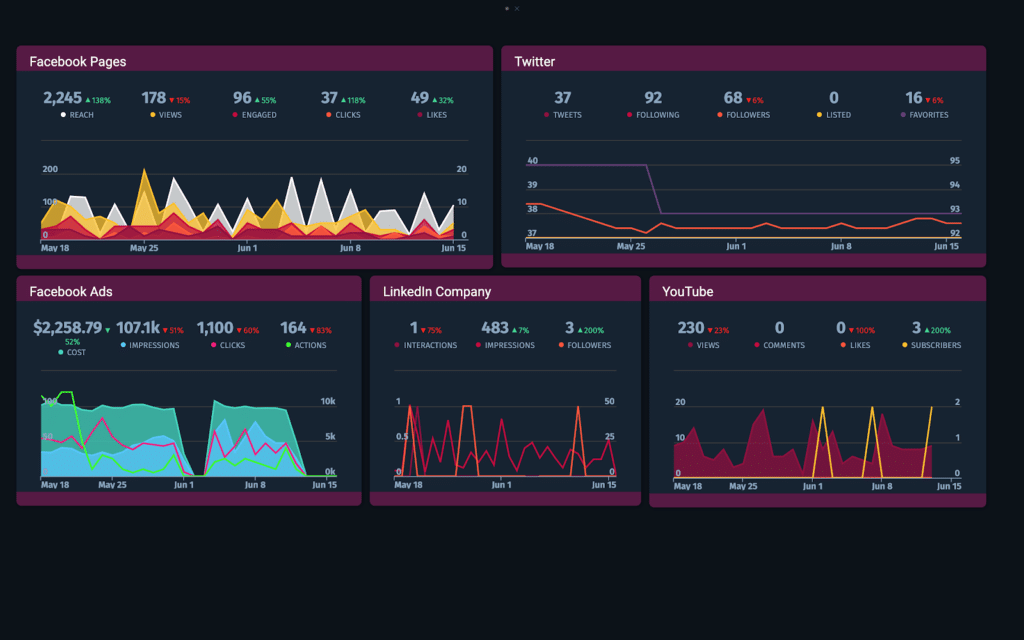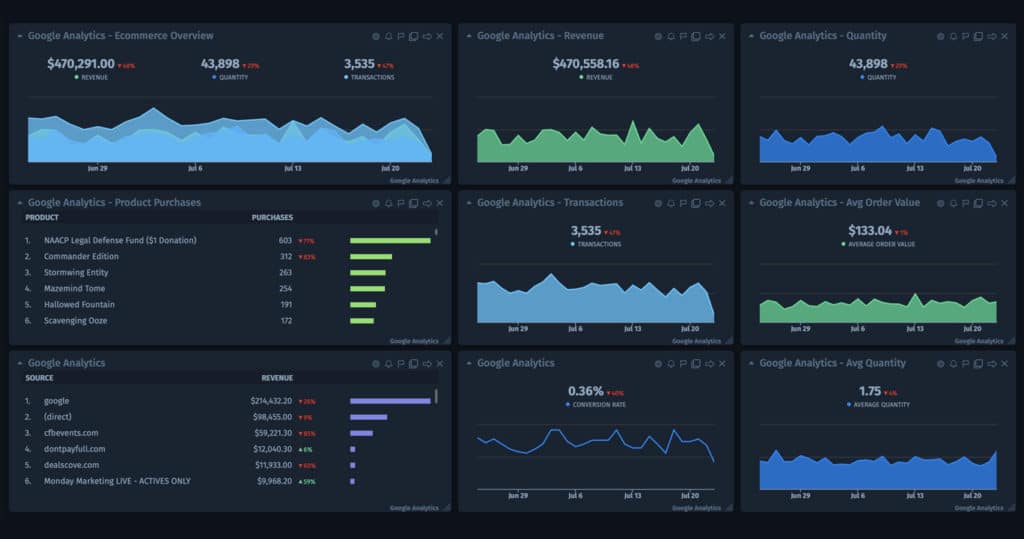Most agency’s list of marketing KPIs is too long. They focus on tracking every marketing metric under the sun rather than those that matter.
What’s worse is that clients don’t even understand most of them. Marketing agency KPIs end up just being numbers on a data dashboard.
In this article, we’re going to take a different approach. Instead of listing a million marketing metrics to cover, we’re going to talk about seven key marketing agency KPIs to track.
Plus, how to set measurable marketing goals that turn your monthly client reporting into a smart, performance management system that helps grow your agency business.
Table of Contents
How to set measurable marketing goals
Many digital marketing agencies understand the importance of setting measurable marketing goals for their clients. By establishing and tracking targets, you can get real-time feedback on your campaign performance and motivate your team to achieve more.

Aramis Herrera, Chief Product Officer at Ivaldi Group
“Setting clear and specific objectives that can be broken down in attainable steps is key to reaching targets, as it pushes you to allocate time and resources to achieve your goals while keeping you, your team, and clients motivated.
Focusing on the smaller milestones allows you to get momentum and feel motivated while allowing you to pivot and correct longer-term goals if necessary.”
But what goals should you set to inform your marketing KPIs? SMART goals, which stands for Specific, Measurable, Achievable, Realistic, and Timed. When you understand each element, you can effectively track the right metrics to measure progress towards a defined goal.
SMART goals are:
- Specific
Clear and straightforward, so you understand what you want to achieve.
Example: we want to build brand awareness for a new product launch.
- Measurable
Define what signifies that you’re making progress towards your goal.
Example: we will generate an additional 1,000 sales-ready leads.
- Achievable.
Is your goal reasonable? Setting goals your team can accomplish within a specific timeframe keeps them focused and motivated.
Example: we will run Facebook ads to a warm audience to generate 1,000 sales-ready leads each month.
- Realistic
Do you have the resources to achieve the goal? For example, an eCommerce business may have a product customers want, but lack a sufficient advertising budget or distribution strategy.
Example: To achieve our goal of targeting warm leads, we will need enough cash for a creative agency to build the campaign and pay for daily ad spend.
- Time-based
What is the time-frame in which you’ll achieve this goal? Set an end-date to keep everyone motivated and aligned. If you don’t reach the goal, take time to figure out why and make adjustments based on your results.
Example: we will run Facebook ads to a warm audience to generated 1,000 sales-ready leads each month for Q2.
Some other examples of SMART marketing goals you can set are:
- Within six months, we will rank on the first page of Google search results for the keyword, “italian restaurants fort lauderdale florida.”
- We will generate 1,000 new leads from our landing page by the end of this year.
- We will increase creation and publication of compounding blogs from current 4 per month to 10 per month within six weeks.
- We will increase net revenues from $2 million per year to $2.5 million per year within one year.
Top 7 marketing KPIs to measure for clients

Angela Allan Founder, Mads Collective Group
“Clients love visibility. By tracking business metrics, it means you can show them, at a glance, what is generating ROI in paid campaigns. When it comes to organic posts, you can show them what is performing and what’s not, so together, you can start doing more of the right things that attract their prospects. By tracking specific key performance indicators, you can prove to clients that your strategies are not only working, but bringing in leads and sales, and this ensures they want to keep working with you. It means you can secure reliable recurring revenue, too.”
Now that you understand how to set SMART marketing goals for your clients, let’s look at what KPIs you should use to measure each target’s progress.
1. Customer Lifetime Value (CLV)
Customer Lifetime Value is the total worth of a customer throughout their relationship with a business. It allows you to determine the net profit you’ll make off each new customer you get based on your customer acquisition costs.
For example, if a new customer costs $30 to acquire, and their CLV is $40, then that customer is considered profitable. You can use this information to target similar audience segments and find new ways to increase the value of existing customers to drive growth.
The formula for Customer Lifetime Value is:
(Average Purchase Value x # of Average Purchase Frequency Rate) X Average Customer Lifespan
An increasing CLV means you’re keeping your clients’ customers happy, reducing customer churn, and connecting with leads the right way.
2. Website traffic to lead ratio
A website is often the first point of contact a customer typically has with a business. A marketing agency needs to be aware of how successful this contact is, which is expressed as your website traffic to lead ratio.
This will allow the team to understand the website conversion rate of the website and the quality of website traffic.
You can measure the percentage of website leads with the following calculation:
(# of leads from website) / (total # of website visitors)
Once these numbers are broken down, you can look at ways to increase the conversion rate and turn more website traffic into customers. You can also use this formula to figure out the conversion rate of different conversion points on your website: such as contact form completions, lead magnet downloads, and more.
3. Marketing Qualified Leads (MQL)
Increasing website traffic and converting visitors into leads is good for business. Just because a person becomes a lead, it doesn’t mean they will buy from you.
A Marketing Qualified Lead (MQL) is someone more likely to become a customer than other leads. The qualification process is different for every business, but you can typically base a benchmark off of:
- meeting your buyer personas.
- specific demographic factors such as age or location.
- what webpages someone visits.
- what lead magnets they download or complete.
- repeat engagement with business content.
Once you have these benchmarks in place, you can go beyond measuring general leads and show how you make a meaningful impact on the company’s bottom line. Remember, if a lead doesn’t become an MQL right away, it doesn’t indicate they won’t become one.
4. Customer Churn
Customer churn is the rate at which customers stop doing business with a company. Depending on your client’s industry, it can be upward of 25 times more expensive to get a new customer than selling to an existing one.
Keeping track of customer churn for a client can help you:
- identify customers at risk of leaving your clients’ business.
- put more resources into existing customers so they don’t leave.
To determine the number of customers that churned, take all the customers you’ve lost during a time frame, such as monthly or quarterly, and divide it by the total number of customers your client had at the start of the month.
By focusing on churn, you can help clients multiply their sales and marketing efforts by looking at the reasons people leave and making improvements in their product or pricing strategy.
5. MQL to SQL Conversion Ratio
The MQL to SQL Conversion Ratio is sometimes known as Lead to Opportunity Conversion Ratio. In short, it’s the ratio of how many marketing qualified leads turn into sales qualified leads.
Your conversion ratio here is a direct result of your lead generation and nurturing strategies.
The formula for determining MQL to SQL conversion ratio is straightforward:
(# of SQLs / # of MQLs)
6. Social media conversion rates
According to recent social media statistics, Facebook and Instagram have become two of the top channels for people to research and buy products online. Potential customers are getting used to social selling, which is good news for folks managing client social media accounts.
Social media marketing metrics to track can be:
- referral traffic from each social media channel.
- amount of customers converted from each social media platform.
- amount of leads converted from each social media platform.
Regardless, you want to set specific social media SMART goals, as highlighted above, to show a good return on investment.

With reporting and analytics in Cyfe, you can easily show campaign goals and outcomes to understand what’s working and what’s not for clients.
7. Return on investment (ROI)
Return on investment (ROI) measures how much profit you make from a campaign. You calculate the ROI on each campaign, whether inbound or outbound marketing, and reporting on it.

Lauren Petrullo, Owner and CEO of Mongoose Media
“When launching campaigns on Amazon, we have ROI minimum rules to ensure profitability. Historically, we used ACOS (advertising cost of sale) to show the campaign’s profitability — a number represents the percentage of advertising spend that makes up a sale. This should never exceed 12%. However, now that we have ROAS (return on ad spend) on Amazon, we can also show how many dollars in sales we earn based on one $1 or £1 invested in ad spend.”
The formula for calculating marketing ROI is:
(Gross profit – marketing investment)
If you want to truly take your agency to the next level, consider creating a return on investment dashboard for each client with Cyfe.

One thing that sets a great agency apart from the rest is the ability to monitor performance in real-time. Sell your analytics not as reporting, but as a performance management system that shows clients what they need to do to grow their business.

Trilce Jiron, Founder of TBS Marketing
Turn your clients into experts! Explain what metrics mean to you, and how they convert, for example: engagement means interaction, but low conversions might mean a poor sales agent, or au contraire, high conversion means a fantastic sales agent! By being aware, they can take the right actions within their company to keep improving cash flow, and they’ll trust you even more.
Read more: How to Prove Marketing ROI for Clients
Becoming a better digital marketing agency through KPI tracking
These marketing metrics are a good starting point, but they’re not always exactly what each client needs. There are other important secondary KPIs depending on what they want to see in a marketing report based on their target audience, current marketing strategy, etc.
Read this post if you want to learn about five key dashboards every marketing agency needs.



